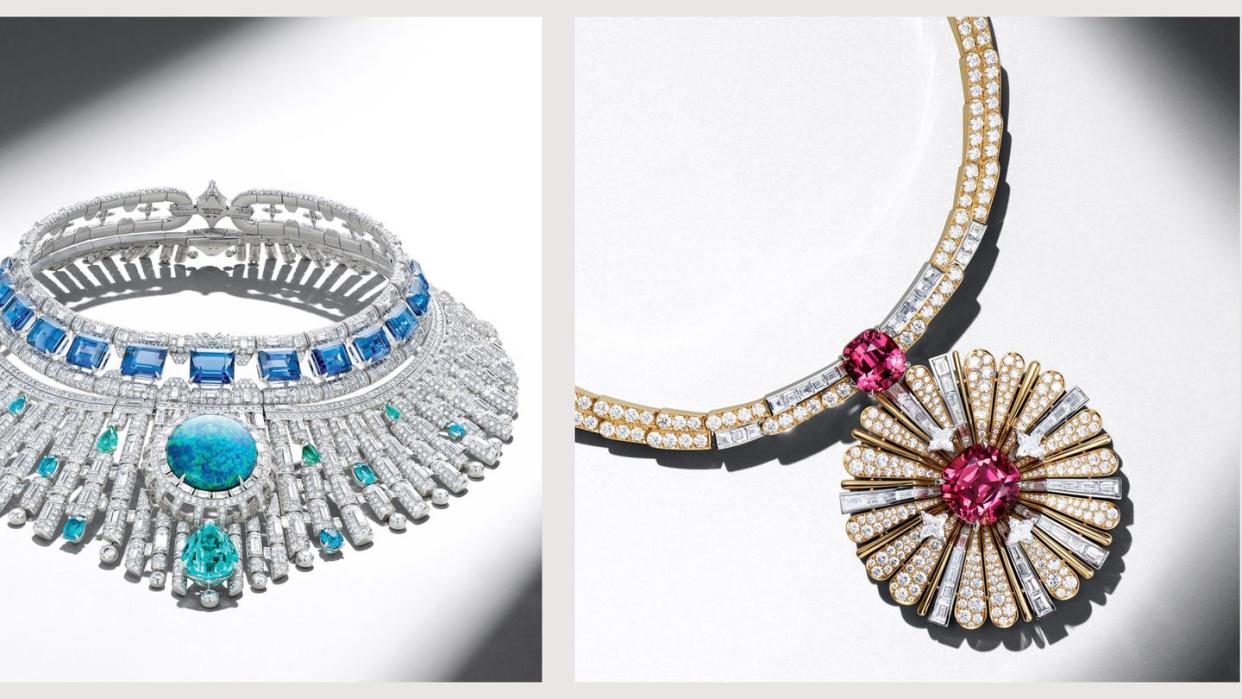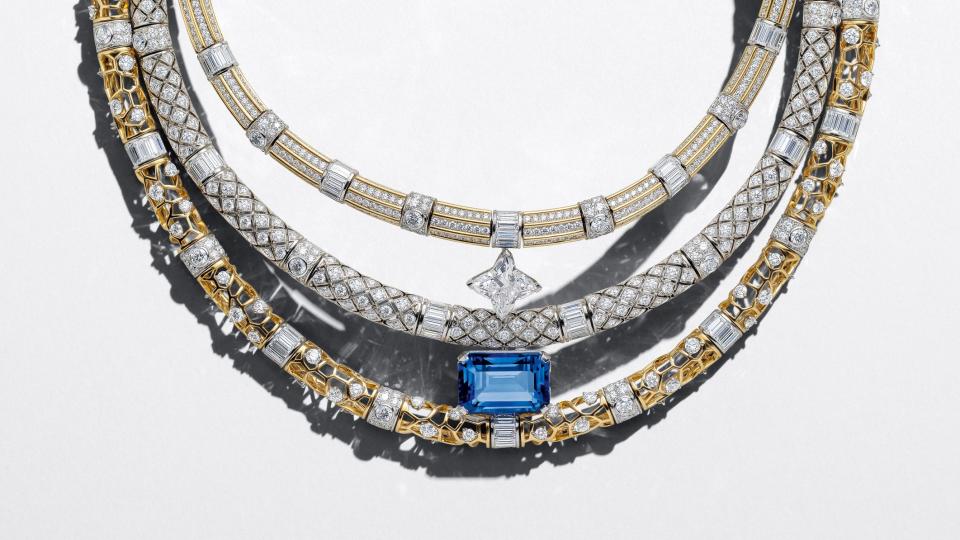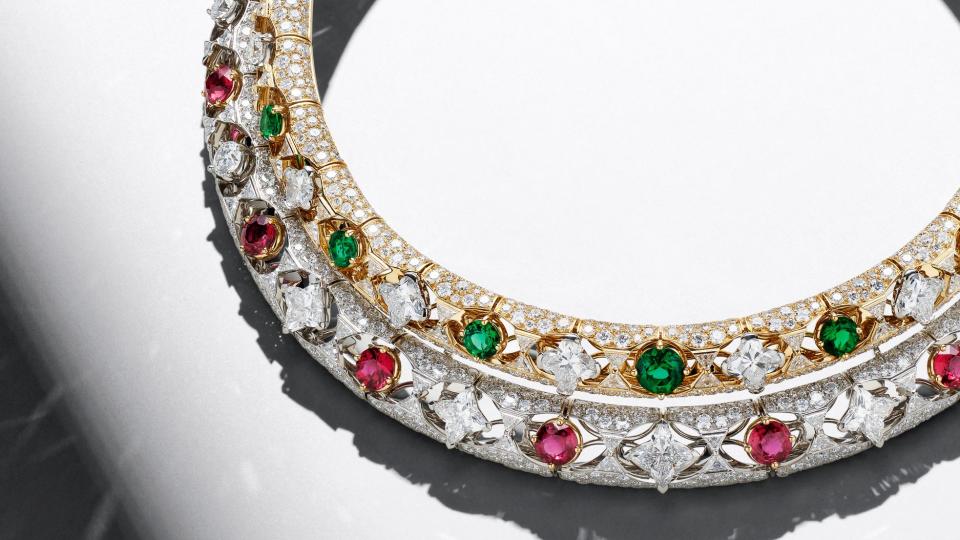Is it Time? Louis Vuitton Reconsiders What High Jewelry Should Be

I was high above the Peloponnese, staring at a diamond bib with a 43-carat Australian opal, a 20-carat Paraíba tourmaline, and 91 carats of tanzanite, and all I could think of was Socrates. We were, admittedly, at the presentation of Francesca Amfitheatrof’s Louis Vuitton High Jewelry collection at Amanzoe, a hotel complex on the east coast of the Greek peninsula, and the room was lit to resemble a cave (different Greek philosopher, I am aware, but let’s free-associate). It suggested to me a Socratic-like method, which I could use to understand the immensity of the aquamarines and yellow sapphires and rubellites and emeralds I was surrounded by and connect them to the talk of tectonic shifts and volcanic eruptions and colossal waves that filled the room. “Beautiful things,” Socrates concluded, around 390 BC, “are difficult.” That evening in Athens, at the base of the Acropolis, choreographer Dimitris Papaioannou created a presentation of the collection. Models walked through the ancient theater Odeon of Herodes Atticus wearing the jewelry, followed by black-clad male dancers with ring lights in front of their faces. At the conclusion of the performance, accompanied by violinist Renaud Capuçon, a woman emerged from a shell, born and then adorned. It was a history of life, the earth, and jewelry, in under an hour.

The exquisite ambition of Amfitheatrof’s High Jewelry for Vuitton issues a challenge: What should this level of jewelry be? What could it be? The boldness of her last five collections interrogates the expectations of the form in both approach and execution. The term “high jewelry” is used to describe the one-of-a-kind pieces created by a handful of houses using the rarest stones and the utmost craftsmanship. The collections are presented to private clients in beautifully staged events around the world. High jewelry is, to borrow a phrase from fashion, haute couture. It is expected to be beautiful and exceedingly well crafted. But to tell of supercontinents and the earth’s evolution? Not so much.

Amfitheatrof’s ideas are epic from the beginning, and they remain so in carat weight and proportion, even as they are shaped into reality to drape against the wrists, necks, fingers, and ears of clients. For Amfitheatrof the secret to jewelry’s possibilities lies in stones and stories. She is one of the most narrative-driven designers in jewelry today. (The great Nicolas Bos at Van Cleef & Arpels is another.) There was a Vuitton collection that began as a mood board of medieval women who changed history and ended with armorlike necklaces inspired by Joan of Arc; in another, space and stars and hours of interplanetary study led to a piece with an 8-carat ruby representing the red planet. Her fourth High Jewelry collection, Spirit, modeled after an adventurous and free figure in the Vuitton mold, had an air of myth about it; one necklace evoked the scales of a dragon—to ward off danger—in gold, diamond, and rare garnet. Amfitheatrof’s work is jewelry as language, not mere decoration.

If the thrill of ideas drives her designs, it is access to rare stones and the Vuitton atelier that allows her intriguing provocations to take shape. Her reverence for both Vuitton’s stone department and its artisans is fiercely felt and expressed. The Place Vendôme atelier, she has said, is “a place where everything is possible. I respect the thousands of hours that go into making the pieces, and what I call the ‘making’ language we all share. I speak that. And our clients feel it—the way each piece is handmade, the engineering behind it. Each fits so well you feel as if you could climb a mountain wearing it.” She calls the stone department the Indiana Joneses of the jewelry world. “They are in the tradition of the old stone hunters, like the adventurers who went to Egypt to find King Tut. It’s a dream come true.”

The Deep Time collection is, in a way, an homage to those hunters, to the way a diamond, formed deep within the earth, can be witness to eons a human cannot fathom. Amfitheatrof calls it a voyage “to a time and place so remote it is perhaps even difficult to comprehend. But at the same time, the stones—these treasures that span millennia—will bring you right to the beginning of the planet, into a history of the world and a mystical geological legacy.”

The Deep Time pieces represent the stages of the earth’s history, from the birth of the planet to the creation of life. A necklace called Gondwana references the supercontinent that comprised what are now South America, Africa, India, Australia, and Antarctica. The seven rows of diamonds and no-oil Colombian emeralds are connected in Amfitheatrof’s design, to reflect how it once was. As the collection moves through time, life emerges. A piece called Seeds is “symbolic of the treasures of birth,” signaling this with 13 almost egg-size rubellites and 256 carats of spessartite garnet cabochons. Could you appreciate the piece without knowing the radical philosophy that spawned it? Absolutely. But that would be too easy—think what Socrates would say.
This story appears in the October 2023 issue of Town & Country.
You Might Also Like

